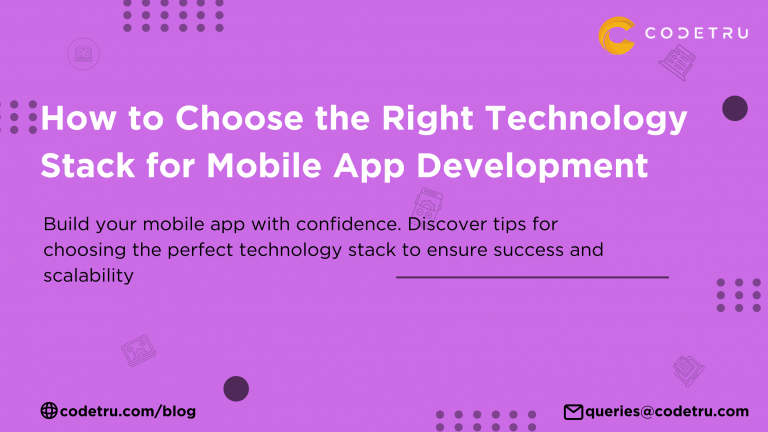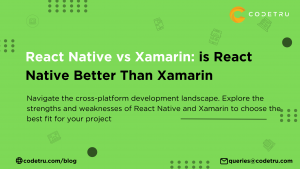Overview
To build a powerful mobile application, you need to use a technology stack that supports your vision and gives your users an amazing experience. A tech stack is the combination of software, hardware and supporting technologies that make up an application. A good tech stack will enhance security while supporting quality development. It should also allow you to incorporate all the features you want in your product right from the start.
Here, you will understand the fundamentals you need to consider when preferring the tech stack and how it influences the overall mobile app development process and approach.
What is Technology Stack?
A technology stack is the combination of various tools, technologies, frameworks, and languages that are employed to create powerful web or mobile applications that augment business growth. A mobile app’s tech stack is categorized into four main classifications: backend (the back-end code), frontend (the user interface code), development (the code that creates apps), and support (additional services such as security).

Android Tech Stack
This will help develop an Android-specific applications. With the open-source platform, you will get the flexibility and adaptability that a mobile app demands.

Android Programming Languages


The Tools
Eclipse IDE
Developers can utilize the Android developer tools plugin created for the Eclipse IDE to shape up their project, incorporate APIs and construct user interfaces. It contains a specified set of tools and technologies for emulation, app development, and testing.
Android NDK
The NDK also called a native application development kit is a tech stack element that lets developers code utilizing C or C++. In fact, you can use native libraries and languages to code the mobile app.
Android Studio
This is a decent and favorably used Android app development tool. It contains a code editor and actuality for Kotlin and Java. It is a visual editor that lets you set up templates, add features, and rev development.
iOS Tech Stack
iOS stack is nothing but the technologies used to develop apps on iPhone, iPad, and iOS-specific devices.


Swift
It is the most popular iOS-specific programming language, it is employed to create most of the apps for this platform. It is effortless to code and debug and provides comprehensive readability.

The Tools
UI Kits:
If you want to provide a swift and soft interface, you can create one using the UI kits.
SwiftUI:
It is the finest fit for the progressive versions of iOS interfaces.
X Code:
This IDE offers the developer all the tools and technologies needed to build an iOS-specific app. It provides essential support for design, coding, and testing.
App Code
It is a robust IDE that supports accelerated app development. It is one of the few development environments that a third party oversees.
Hybrid Tech Stack
With the hybrid tech stack, you can create app solutions for both iOS and Android that are retained in a web application. A few ready-to-use frameworks and tools make it easy for you to provide a functional app for this platform.
Ionic

You can create apps utilizing relevant web technologies such as HTML5 and CSS employing this tool. You can utilize the in-built tools and components to rev productivity and enhance time-to-market.
Cordova

Using Cordova you can create JavaScript-based app solutions retained in HTML with this tool. To create your applications, you can enclose hardware components such as an accelerometer, GPS, and speakers. You can create a solid server-side application using this tool.
Cross-Platform Tech Stack
React Native

If you want to create a native-like cross-platform solution, you should use React Native framework. It allows you to deliver a clean and straightforward interface.
Flutter

Flutter is a growing option for iOS development. It uses the Dart programming language to build beautiful, native-feeling apps for both iOS and Android with a single codebase. This can save time and resources compared to developing separate apps for each platform.
Advantages of Choosing an Appropriate Tech Stack
Less Cost
Utilizing technologies that match your business objectives and budget can help you save on development and deployment costs. A minimum viable product can be developed using cross-platform frameworks. To develop the product, you will only need a few technologies and tools. IoT projects require embedded software development tools, such as Arduino IDE, as part of the stack. By determining the technologies and tools required at the beginning, you can determine the cost and budget of the project.
Accelerates time-to-market
When you choose a technology stack that aligns with your application development needs, you can speed up the launch. Let’s find out how? Imagine you were launching an MVP for your business. A minimal set of features is required to meet your needs.
- The more complex the platform, the more likely it is that you will get caught up in the web of expertise, experience, and knowledge.
- You can, however, launch your MVP app quickly with a mature and straightforward framework.
The right technology stack can accelerate the development and deployment of your app, both on the frontend and backend.
Enhances App Performance
You should choose a technology that matches the performance requirements of your app. Your technology should support native components if you intend to integrate them in your features. Furthermore, if you want an application that can handle heavy loads, you should choose a framework that can scale to meet your needs.
Picking a right technology stack for frontend and backend can increase performance and guarantee your app is competent.
Scalability
You might not realize which technology is the most appropriate for your application if you start thinking about growth after developing it. Anyways, if you trust in development when selecting the technology, you can figure out an easy-to-scale tech stack.
When you choose an efficient technology stack at the planning stage, you can scale your application fast to satisfy the growing business needs.
You can find us in seolist.org’s
FAQs About Choosing The Right Technology Stack For Mobile App Development
1. What factors should I consider when choosing a technology stack for mobile app development?
When selecting a technology stack, consider factors such as the type of app (native, hybrid, or cross-platform), your target audience, budget, project timeline, performance requirements, and scalability needs. Additionally, assess the expertise of your development team and the long-term maintenance of the app.
2. What are the benefits of using a cross-platform tech stack like React Native or Flutter?
Cross-platform tech stacks like React Native and Flutter allow you to develop apps for both iOS and Android with a single codebase. This approach reduces development time and costs, ensures consistency across platforms, and simplifies maintenance. Both frameworks offer a native-like performance and user experience, making them popular choices for efficient app development.
3. Why is mobile accessibility important for my app’s success?
Mobile accessibility is crucial because a significant portion of users access apps through mobile devices. An app that is not optimized for mobile use can lead to a poor user experience, lower engagement, and reduced retention rates. Ensuring your app is responsive and performs well on various mobile devices enhances user satisfaction and boosts its overall success.
4. How can choosing the right technology stack impact my app’s performance?
Selecting an appropriate technology stack can significantly enhance your app’s performance. The right stack ensures efficient coding practices, seamless integration of features, and optimal utilization of hardware and software resources. This results in faster load times, smooth navigation, and a more responsive user experience, which are critical for retaining users and gaining positive reviews.
5. What are the advantages of using a native tech stack for Android or iOS app development?
Using native tech stacks like Java or Kotlin for Android and Swift for iOS offers many advantages. Native development provides better performance, access to platform-specific features, and an enhanced user experience. It allows for easier debugging and maintenance, since the code is specifically designed for the operating system, resulting in fewer compatibility issues and better overall app quality.







